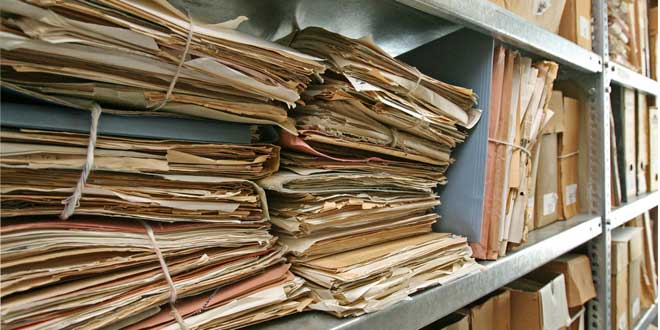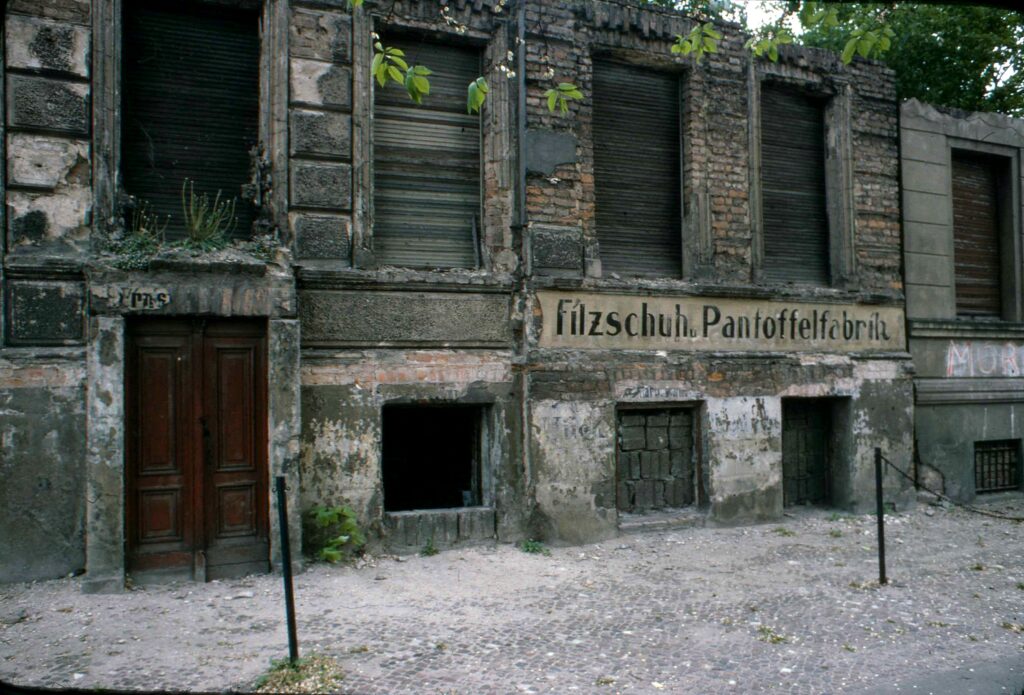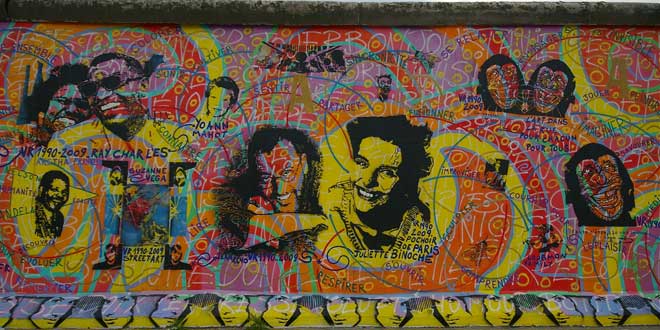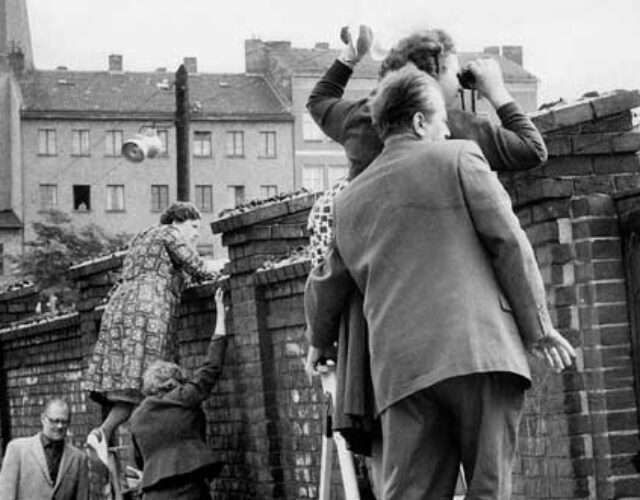An irregular sequence of bronze circular plaques lies parallel to Bernauer Strasse, a street where the Berlin wall once split the neighborhood of Mitte from the neighborhood of Wedding. They tell of successes and failures among those who jumped from windows of apartment buildings that abutted the wall, shimmied down ropes, or navigated underground tunnels: “30.09.1961, Flucht, Frau K und Kind”—Mrs. K’s escape with her daughter. “07.07.1968, Fluchtversuch und Festnahme”—“attempted escape and capture.” Other reminders of this city’s Communist past are more chilling: crosses near Berlin’s Spree River mark where people were shot to death trying to flee to West Germany.
More than 50 years have passed since 1961, when the Berlin wall was built, and 23 have passed since it was torn down. The plaques and crosses are just the overt reminders of the desperation felt by many living behind the wall in the formerly Communist German Democratic Republic (GDR)—a desperation that spurred some to find any way possible to escape repression, at great risk to their own life and that of their families.
Scientists were not immune to the spying and harassment suffered by ordinary citizens of the GDR. They too were under surveillance by the Ministry of State Security, or Stasi for short, and were prodded to show loyalty to the regime, which sometimes meant reporting on the activities of coworkers. But on November 9, 1989, everything changed. Against the backdrop of months of protests that had begun in Leipzig and then spread across the GDR, Communist Party officials met for a rather mundane General Assembly. The group decided to relax travel restrictions to the West in order to appease protestors—but critically, the decision did not include a detailed plan for implementation. After the assembly Günter Schabowski, a Communist Party official who had missed the travel-relaxation discussions, gave a press conference. As he read out a rather lackluster list of the day’s achievements—in which was buried the plan to ease travel restrictions—journalists asked when the new travel rules would be enacted.
In the now quintessential example of how an improvised answer can change the course of history, Schabowski waffled and then answered “sofort”—“immediately.” As West Berlin radio and television announced the new freedom to travel, people on the East side of the wall who had tuned into the German news flocked to several border-crossing stations. The station guards were quickly overwhelmed; they had heard the same news reports and failed to reach any authorities who might have clarified the situation. Succumbing to the pressure of the crowds, the guards opened up barriers that were never to close again.

The flood of people that spread to the West and the subsequent reunification of Germany also had a massive impact on scientists in the former GDR. As teams of West German scientists traveled to the East to evaluate which institutes would remain open and which would be closed, thousands of former GDR scientists lost their jobs. Money flooded into the East, meant to build dozens of shiny new institutes indistinguishable from their Western counterparts. Some of these new institutes hosted researchers who worked in the former GDR, but many were led by West German or international scientists.
Germans refer to the entire transformation—from the Berlin wall’s collapse to German reunification—with a gentle euphemism, “die Wende,” or “the changeover.” This simple word embodies the massive changes that occurred after the wall came down, including opening the Stasi’s huge archives to the public. Since 1989 many scientists who suffered behind the wall have taken stock of this past. Here are a few of their stories.
Uwe Rosenthal
Age 39 on November 9, 1989
“The Stasi’s code name for me was ‘Nickel’ because I worked with nickel catalysts,” says Rosenthal. After the wall came down, Rosenthal requested the hundreds of pages of Stasi surveillance files collected on him in an effort to make sense of the difficulties he had experienced in the years before the changeover.
In 1989, with a Ph.D. and a nearly completed German habilitation, then a prerequisite for an academic career in science, Rosenthal’s career should have been on an upward trajectory. Unfortunately for Rosenthal his PhD adviser had fled the GDR the previous year, after receiving a travel visa to attend a family birthday party. “The Stasi believed he was selling research secrets to the West,” says Rosenthal, adding that the idea was preposterous. In reality his adviser had just wanted freedom unavailable in the GDR. “I was totally rattled,” Rosenthal says of the time after his adviser’s escape. “I was under complete surveillance.”
Left in limbo Rosenthal was deemed by the Stasi to be a security risk and unsuitable for a scientific career. Among the mass of very detailed, sometimes banal, Stasi reports on his daily life, Rosenthal says he came across evidence that the spy agency’s surveillance extended into West Germany. Case in point: a copy of an internal letter written by Rosenthal’s former PhD adviser to the director of his new research institute in Mülheim-Ruhr, inquiring whether a position could be made available for Rosenthal in the event of his leaving the GDR. The well-intentioned and seemingly safe inquiry backfired for Rosenthal; the Stasi got wind of it, which led to even more problems for him. Rosenthal now knows the Stasi heard about this letter through Communist Party member researchers who had received permission to tour the institute in Mülheim and who had found a way to riffle through the office of his former supervisor.
Luckily for Rosenthal his impossible situation came to an end a year later in 1989. Soon after the wall collapsed, he left to join his former adviser at the Max Planck Institute for Coal Research in Mülheim-Ruhr. The following year Rosenthal returned to the old East for a new job leading a research department at the same institute where he had initially been blacklisted. His current circumstances would have never been possible behind the wall, Rosenthal says.
Christoph Naumann
Age 19 on November 9, 1989
Christoph Naumann knew he wanted to study chemistry at a university but could not stomach the mandatory military service for a regime he loathed. So in August 1989, just weeks before the start of the protests that would eventually bring down the wall, Naumann decided to escape by traveling to Hungary and then walking over the border to Yugoslavia. Border guards were suspicious of young men traveling alone—many had tried escaping the GDR in this way—so Naumann’s sister went with him on the train to Hungary, though in a different coach, hiding in her underwear the 40 Deutschmarks in cash that would start his new life in the West. Naumann also had help from a train conductor, who smuggled his academic records across the border. Some 20 years after he escaped from the GDR, during which he worked or studied as a chemist in France, Canada, England, and Australia, Naumann moved back to Berlin. He now lives a short walk from the Bornholmer Bridge, a former crossing between East and West, where the first crowds crossed to the West on November 9, 1989.
Beate Koksch
Age 21 on November 9, 1989
Many young adults struggle with choosing a career, but Beate Koksch always knew she wanted to be a biochemist. In 1985, 17-year-old Koksch figured that her top marks in science made her a shoo-in for a university biochemistry program. Then one day, as graduation approached, her school principal announced in front of her classmates that Koksch had been denied entry to biochemistry programs.
An extremely upset and confused Koksch faced more unpleasant surprises. An hour later she was called to the principal’s office and found a Stasi operative waiting for her. Koksch says he started by mentioning her failure to get a spot at a university. In the next breath he invited her to study at a university that trained Stasi agents. Her failure to get into a biochemistry program had likely been a Stasi recruitment ruse. “It was awful to have the Stasi ask you to join them,” Koksch says. “I thought, ‘Why me? Have I been too good?’ To think that they saw me as a good candidate made me feel sick.” At the same time, Koksch knew that she couldn’t out-and-out refuse the Stasi agent’s invitation for fear of seeming rebellious or disloyal to the regime, which could hurt her family’s career prospects as well as her own. “I said I needed to speak to my father and would give an answer tomorrow.”

That night was not a pleasant one in her household as the family brainstormed for a way out of the predicament. In the end Koksch decided on a sequence of watery excuses for refusing the Stasi offer, such as she was thinking of getting married and settling down with someone who had many family members in the West—contacts the Stasi would not approve of or permit. Another excuse involved her thinking processes: she was completely right-brained and too inept for the left-brain thinking required for social sciences.
Luckily for Koksch the Stasi believed her story. The following year she reapplied to a chemistry program at the Technical University in Leuna-Merseburg and was accepted. Today she is a professor of organic and natural-products chemistry at the Free University in Berlin.
Joachim Sauer
Age 40 on November 9, 1989
Many GDR scientists needed only 1.5 grams for promotion to senior scientist or professor, says Joachim Sauer, now a computational chemist at Humboldt University in Berlin. “This was the weight of the Communist Party sticker.”
Before the wall fell, joining the Communist Party was an essential step for career advancement. For Sauer and other scientists who didn’t have the political stamp of approval, permanent postdoc-level positions were the most they could hope for. They also had to avoid making any provocative or critical statements about the Communist Party. Even so, Sauer says, “Staying quiet and keeping to yourself was not always enough.”
For example, late on a Friday afternoon in 1986, Sauer recalls the arrival of an unexpected guest in his office at the Institute of Chemistry in East Berlin. The institute’s Communist Party secretary showed up to request—in reality to demand—an opinion essay about a recent Communist Party congress, a demand completely unrelated to Sauer’s work as a theoretical chemist. The essay, Sauer was told, would be posted on the institute’s notice board for all to read.
It was a catch-22. “If you were to write what you think, you were in trouble,” says Sauer. “If you were to write what they wanted you to write, then you would deny yourself.” Sauer spent a stressful weekend searching for a solution to the impossible conundrum. In the end he says what he wrote was “okay on the surface, but had a double meaning, a small hammer that gave a message.” Sauer says the experience seems almost funny now, but not then. The essay was posted for only a few hours before officials decided to remove it.
Living behind the Berlin wall was not just personally stressful but also professionally frustrating. By the 1980s the GDR’s economic problems combined with Western embargoes meant research equipment was often outdated. As a computational chemist, Sauer says it was frustrating to be stuck behind the wall just as VAX computers were shrinking from building sized to room sized.
But sometimes equipment was unofficially available; the GDR regularly smuggled in from the West all sorts of things, from exotic fruit to medical equipment. For example, Sauer says his research institute had managed to get embargoed computers via Austria, a fact that the institute’s administrators tried to keep secret by keeping the machines in a locked room and placing the terminals in another room, one open to the scientists. Sauer says he and his fellow scientists were skilled enough to extract the system information and so learned the computers’ origin.
After the wall came down, Sauer went to work for a software company in San Diego before being recruited back to Germany. A few years later he was awarded a professorship at Berlin’s Humboldt University. Sauer continues his quantum computational research—with brief breaks to entertain international heads of states with his wife, German Chancellor Angela Merkel. Sauer’s new workspace is in a recently renovated lab on Humboldt University’s Aldershof campus, where the GDR’s Institute of Chemistry used to sit, just across from a former Stasi military barracks.
Heinz Mustroph
Age 38 on November 9, 1989
India’s flamboyant Bollywood film industry may seem worlds apart from the factories of Communist East Germany, but business made them bedfellows. Before 1989 Heinz Mustroph worked as a chemist for Filmfabrik Wolfen, a government-owned company that supplied color film to primarily Bolly-wood clients.
After the Berlin wall collapsed, workers at the film company tried to keep business alive, but clients forced to pay in more expensive West German Deutschmarks soon went elsewhere. The color-film company—like many businesses in the East—couldn’t stay afloat. Without a job Mustroph partnered with some former colleagues to start a contract research company that in 1997 morphed into FEW Chemicals, a manufacturer of specialized dyes, also based in Wolfen.

Mustroph was in his late 30s when the Berlin wall fell, young enough to adapt to the new political and economic realities, even though the adjustment was not always smooth. “Although I worked much harder in the years after the wall came down than before, life is better for me now. Now, if someone wants to try something new with their lives, they make their own limits,” he says, instead of being dictated by government.
Gunter Fischer
Age 46 on November 9, 1989
The GDR’s decaying equipment and a lack of basic research supplies meant scientists didn’t have the resources to do science, but they did have plenty of time to sit in their offices and think, says Gunter Fischer. As a biochemist at Martin Luther University in Halle during the late 1980s, Fischer used his free time to think about how proteins fold. He came up with two theoretical ideas that garnered the GDR scientist rare Nature papers in 1987 and 1989—publications he acquired without asking for, or receiving, the necessary consent from the Stasi or his university administration.
At the time, getting a paper published in a high-profile Western scientific journal generally required East Germans to collaborate with a Western scientist—another taboo, says Fischer. All professional contacts between Eastern and Western scientists had to be sanctioned and mediated by the Bureau of International Relationships. Fischer says it was frustrating to work with this bureau. “If I wanted to write a letter to a U.S. or Italian scientist, I could not do it directly. I had to go through the bureau. But if you didn’t hear a reply, you didn’t know if the bureau had even sent the letter or whether a response had been received, or whether it had been thrown into the wastebasket.”
Typically, contact with Western scientists was only possible by traveling to conferences in Poland or Hungary, where rules about international interactions were laxer than in the GDR. However, for the last 300 years Fischer’s hometown had been the headquarters of the Leopoldina, a scientific academy. Even during the years under the GDR regime it was able to host scientists from the West.
There Fischer met Franz X. Schmid, a biochemist at the University of Regensburg in then West Germany who visited the Leopoldina once or twice a year. Schmid helped Fischer get his work published in Nature, and he repeatedly made official requests for Fischer to give a talk in Regensburg. Fischer also received many invitations from the scientific community in the United Kingdom, but as late as September 1989 he was denied a travel visa. Fischer says his Stasi files state that these refusals were because he was not a Party member “and because I wasn’t convinced that the Communist system was best and thus I wouldn’t give a good impression about the GDR to the hosts.” Somehow the Stasi never realized that Fischer had published in Nature. “In those years I guess the Stasi had other problems. Or maybe they were behind in their reading of journals.”
Fischer was finally granted a travel visa in November 1989 and was in Bayreuth, West Germany, when he heard that the wall had come down. “I could barely believe it. I thought I had to accept that I would spend my whole life in the GDR.” Fischer had a wife and children in the East and never considered escaping.
Fischer is currently the director of the Max Planck Research Unit for the Enzymology of Protein Folding, the only director at one of the 80-plus institutes in the Max Planck Society who worked as a scientist in the former GDR.
Federal elections will be held in Germany in 2013, the seventh since reunification. More than two decades have passed since the cold war ended, and it’s tempting to see the Berlin wall as an increasingly antiquated artifact—just a large, steel-reinforced, concrete structure that fell down years ago. But for many people—from scientists to street cleaners—the spying, bullying, and oppression they lived through behind that wall will continue to be part of a very personal chronicle.
Sarah Everts was a 2011–2012 Ullyot Scholar at CHF’s Beckman Center. She is currently the European correspondent for Chemical & Engineering News. A version of this story appeared in C&EN in 2009.




